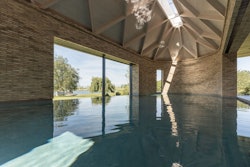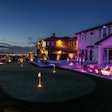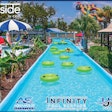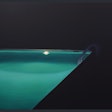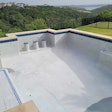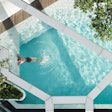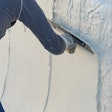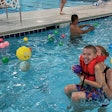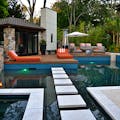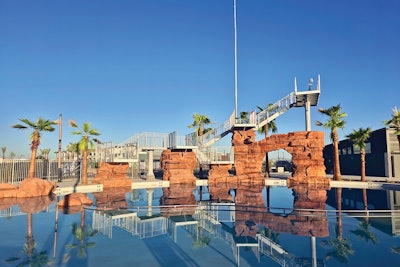
Aquatic facilities and outdoor living areas are different from all other forms of leisure/entertainment space, because they seek to mimic the environment in which our ancestors lived, before modern cities. That is their attraction, unlike movie theatres, nightclubs, and the like. Their popularity rests on the innate connection between man and nature, somewhat diminished in modern life, but which remains strong at our core.
These facilities tap into man's affinity for water in particular, our most basic need, but also for our deep-seated love for the natural environment.
This love of nature, specifically the nature of Arches National Park, one of the five great national parks of Utah, was the genesis of a compelling faux rock feature at Cannon Beach in Mesa, Ariz.
 Soul-stirring views of the rock formations at Arches National Park led designer Zayvian Camacho, pictured, to bring that feeling to the Cannon Beach waterpark.
Soul-stirring views of the rock formations at Arches National Park led designer Zayvian Camacho, pictured, to bring that feeling to the Cannon Beach waterpark.
One of the lead designers at Rico Rock, Zayvian Camacho, had fallen under the spell of the desert spires, arches and rock structures that greet hikers near Moab, Utah. In an act as old as cave paintings, he sought to capture the magic of nature and bring it home.
After talking with the team about the look and feel they were going for, explains Camacho, "the arches just made sense in my head. I said to the team, if we are putting rock on these spires and the spires are right next to each other, why don't we connect them and make a beautiful archway like the 'delicate arch' in Utah. The team loved the idea, so we went with it!"
There were several challenges to create and install these cast concrete rock structures. The biggest challenge being the fact that the faux rock structures were fabricated in Seguin, Texas, and shipped to Mesa, Ariz., where they were installed.
"We spent three to four weeks working on the structure — this included everything from starting with the concept drawing to turning it into a true vision," explains Camacho. "I also took one trip out to the facility to visualize the space, take some measurements, and then brought all of the information back with me to Texas."
Camacho explains that he marked it out on the floor in Rico Rock's Texas fabrication facility, doing the best he could to get the sense of scale. Camacho then used Lumion software to design the steel frames, manipulated them, and did all the necessary calculations to start building the GFRC rocks.
For the arch itself, the vision turned into pieces of GFRC faux rock. These weighed somewhere between 3,000 to 4,000 pounds each. "The entire arch alone weighed more than 13,000 pounds," says Camacho. "Building this very large, heavy structure in components in Texas, and then shipping it all the way to Arizona and making sure it all fits properly… that was the challenge, and I lost a lot of sleep over it, but it was worth it." When it was installed, without a hiccup, he was ecstatic. "I was so pleased with the final result. This is my favorite project thus far. It feels like a real accomplishment."
 The arch is built from pieces of GFRC faux rock. These weighed somewhere between 3,000 to 4,000 pounds each, for a total weight of more than 13,000 pounds.
The arch is built from pieces of GFRC faux rock. These weighed somewhere between 3,000 to 4,000 pounds each, for a total weight of more than 13,000 pounds.
SHIPPING AND HANDLING
In order to ship the rock structure, the team used a telehandler — a type of extended-reach forklift with a 40-foot boom. This was used to maneuver the pieces into place using heavy-duty straps through 5/8-inch holes in each piece. All of the pieces were moved onto a flatbed, strapped down and hauled to Arizona.
Once in Arizona, the structure was unloaded and placed onto concrete footings made to spec by Shasta Pools, the pool contractor on the project. The GFRC frame structures were placed on top of the concrete footings and the rocks were erected using bolts, washers and welding. It wasn't easy to install the GFRC structure over a deep swimming pool. When you look at the diving platforms, it appears that the rock formations are supporting the diving platforms even though they bear none of that weight. The platforms are supported using poles manufactured by SPLASHTacular.
The main color of these GFRC rock structures was applied at the facility in Texas using what Rico Rock calls "Sedona-Red," which is an integral color used in the fabrication of the cast concrete. The company also did the seaming and shot the joints at their facility so that most of the work was complete upon arrival in Arizona. Once the structure was erected, the team only had to seam the areas where the pieces stacked on top of one another using type S mortar. Stains were used to give the rock feature its highlights. Additionally, the finishers used an antiquing process to bring out the cracks using reddish brown colors to create some depth of red in the rock. This process is where the on-site artistry happens. The on-site staining and coloring techniques enhance the geology of the cast rock to give it a truly natural look.
In addition to the large spires and arches of the diving platforms, Rico Rock added additional faux rocks in the area to pull the look together throughout the new facility. Several underwater/ inwater boulders were created that defined corners at the edge of a staircase and at the end of a bench, for example. These rocks were different from the GFRC used in the arches. Instead, these were traditional faux rock style pieces where rebar is used with real-rock casts that work like pour-in-place concrete forms. The rock is filled up with 3000 psi concrete vibrating as it is poured to be sure there aren't any voids in the rocks. Then, the rocks are waterproofed and hand-textured over the top with an integral color mortar to match the other rock color aesthetics and provide a visual continuity. Most of these rocks were underwater with about 16 inches of the rock appearing about the water line.
The client at Cannon Beach is ecstatic about the complete GFRC rock installation. It uses a famous natural arch to give the pool an identity, and it's the most visible and exciting part of the project outside of the waves in the surf pool.
"I was really blown away at how perfect it came out," says Camacho.
This article first appeared in the April 2025 issue of AQUA Magazine — the top resource for retailers, builders and service pros in the pool and spa industry. Subscriptions to the print magazine are free to all industry professionals. Click here to subscribe.


























